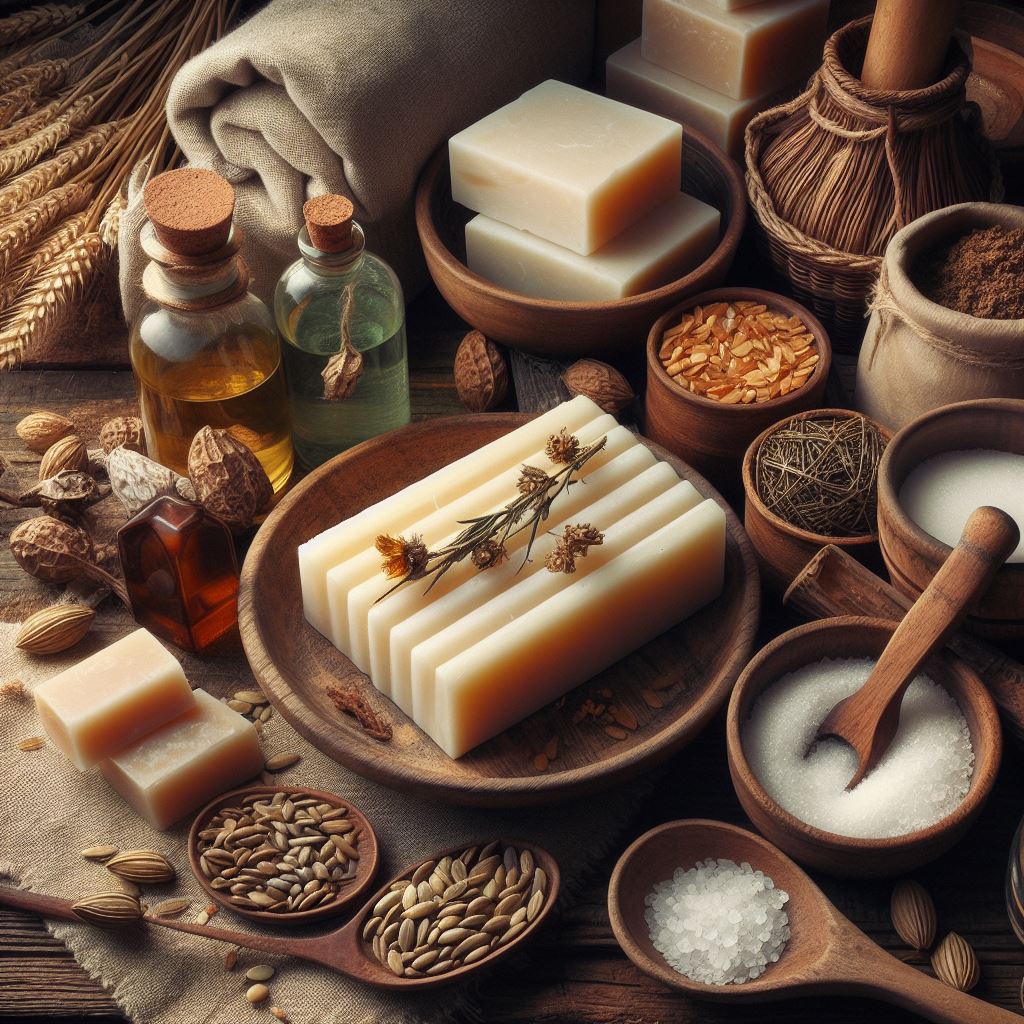Lye soap vs. Carbonate soap

Exploring the Chemistry of Lye Soaps vs. Carbonate Soaps At Savage Soapers Club, we’re all about breaking the mold and diving deep into the sudsy science of soap-making. Today, we’re tackling a topic that’s been bubbling up in the soap-making community: the differences between traditional lye soaps and carbonate soaps. Let’s lather up some knowledge! 1. The Basics: What Exactly Is Soap? Soap is the result of a chemical reaction that transforms fats or oils into a substance that can emulsify oils and wash away grime. This process, known as saponification, involves combining fats with an alkaline substance to produce soap and glycerin. 2. Traditional Lye Soaps: The Classic Approach Lye soaps: In the world of soap-making, lye (sodium hydroxide, NaOH) is the go-to alkali for saponification. Here’s how it works: Saponification Reaction: Triglycerides (fats/oils) react with lye to produce soap and glycerin. Triglyceride+3NaOH→Glycerin+3Soap Molecules Process Details: Mixing: Fats are melted and combined with a lye solution. Emulsification: The mixture is blended until it reaches “trace,” indicating that saponification is underway. Curing: The soap is poured into molds and allowed to cure, hardening over time. Carbonate Soaps: Carbonate soaps utilize weaker bases, such as sodium carbonate (washing soda, Na₂CO₃), instead of lye. Here’s the scoop: Neutralization Reaction: Free fatty acids react with sodium carbonate to form soap and bicarbonate. Fatty Acid+Na2CO3→Soap+NaHCO3 Key Differences: Pre-Hydrolysis Needed: Fats must first be hydrolyzed into free fatty acids, as sodium carbonate isn’t strong enough to break down triglycerides directly. Milder pH: Carbonate soaps typically have a pH closer to that of the skin, making them gentler. 3. Comparing the Two: Lye Soaps vs. Carbonate Soaps Aspect Lye Soaps Carbonate Soaps Alkali Used Sodium Hydroxide (NaOH) Sodium Carbonate (Na₂CO₃) Reaction Type Saponification Neutralisation pH Level Higher, more alkaline Closer to skin’s natural pH Need for Pre-Hydrolysis yes no Texture Typically harder Often softer 4. Why Aren’t Carbonate Soaps Made with Lye? Great question! The primary reason is the nature of the chemical reactions involved: Strength of the Base: Lye is a strong base capable of breaking down triglycerides into glycerin and soap in one step. Carbonate’s Role: Sodium carbonate is a weaker base and cannot saponify fats directly. It requires the fats to be broken down into free fatty acids first, which it then neutralizes to form soap. In essence, using lye in carbonate soap-making would defeat the purpose, as lye initiates a different chemical pathway. Conclusio Both lye soaps and carbonate soaps have their unique characteristics and benefits. Understanding the chemistry behind each can help you choose the right soap for your needs or inspire you to craft your own. Whether you’re a fan of the traditional lye method or intrigued by the milder carbonate approach, there’s a world of soapy science to explore.
Understanding Lyes, Alkaline Substances, and NaOH

Understanding Lyes, Alkaline Substances, and NaOH Discover the powerful world of lyes and alkaline substances! From their chemical properties to real-world applications like cleaning and manufacturing, learn how these compounds shape our industries while navigating their potential hazards. Get ready to dive deep into the chemistry behind NaOH and its role in our daily lives! Lye: A lye is an aqueous solution of a hydroxide. Lyes are alkaline, meaning they have a pH value > 7. Lyes can decompose organic materials and may cause burns. Examples of lyes include sodium hydroxide (NaOH), potassium hydroxide (KOH), and calcium hydroxide (Ca(OH)2). Alkaline Substances: Alkaline substances are bases that, when dissolved in water, release hydroxide ions (OH-). Lyes are a subset of alkaline substances. Not all alkaline substances are lyes, for example, sodium bicarbonate (NaHCO3). Alkaline substances have the following properties: They have a pH value > 7. They neutralize acids. They saponify fats into soap. NaOH: NaOH is the chemical formula for sodium hydroxide. Sodium hydroxide is a white crystalline substance. It is strongly alkaline and breaks down in water to form caustic soda. Sodium hydroxide is used in various industries, such as in the chemical industry, in the food industry, in paper production, and in cleaning. In summary: Lyes are aqueous solutions of hydroxides. Alkaline substances are bases that release OH- when dissolved in water. Lyes are a subset of alkaline substances. NaOH is the chemical formula for sodium hydroxide, a strongly alkaline substance that decomposes in water to form caustic soda. Important: Lyes and alkaline substances can be hazardous. When handling them, wearing protective gloves and goggles is advisable. In case of contact with lyes or alkaline substances, rinse the affected area immediately with water.
Oldest known soap recipe!
Overlay mit Bild Oldest known soap recipe An approximate translation of the ancient Babylonian soap recipe. Ingredients: Water Ash from a fire Rendered animal fat or vegetable oil Instructions: Collect the ash from a fire and mix it with water. Boil the mixture to create a concentrated liquid. Melt the animal fat or vegetable oil in a separate container. Mix the concentrated ash liquid with the melted fat or oil. Allow the mixture to cool and solidify. Cut the solidified mixture into bars for use. Note This recipe is approximate, as the original recipe was written in ancient cuneiform script and may have included additional instructions or ingredients that have been lost over time. The exact proportions of the ingredients and the specific method of preparation may also have varied depending on the individual soap maker.
Alchemy in Soaping

Alchemy in soap making Magical Ingredients in Ancient Soap Formulations: Unveiling the Alchemy of Cleansing The formulations of ancient soaps continue to astound with their inclusion of exotic ingredients that transcend the simple blends of fats and ashes. Across diverse cultures, a belief persisted that specific plants, herbs, or minerals possessed magical cleansing properties. The addition of these mystical elements transformed the act of soap-making into a ritualistic and spiritual endeavor. The Mystical Art of Soap-Making in Ancient Egypt In ancient Egypt, renowned for its advancements in various sciences, soap-making took on a particularly magical quality. The use of natron, a naturally occurring mixture of sodium carbonate and sodium bicarbonate, was prevalent in their soap recipes. Natron was not merely a cleansing agent; it held sacred significance, believed to have purifying properties that extended beyond the physical realm into the spiritual. The Spiritual Alchemy of Soap-Making in Ancient China In ancient China, soap-makers explored the magical properties of herbs like ginseng and lotus. These botanical elements were thought to enhance the soap’s ability to cleanse not just the body but also the spirit. The subtle fragrances of these ingredients were considered conduits for positive energy, creating a holistic cleansing experience. Alchemy of the Ages: European Soap-Making and Mystical Ingredients Interestingly, in the Middle Ages, European alchemists sought to combine the mystical with the practical in soap production. Substances like frankincense and myrrh, long associated with spiritual rituals, found their way into soap recipes. The belief was that these aromatic additions elevated the soap’s purifying effects to a higher, almost divine level. Unveiling the Mystical Legacy of Ancient Soap-Making The use of gemstones was not uncommon in some ancient soap formulations. In India, for instance, soap-makers integrated powdered gemstones like amethyst or moonstone, believing that the energy stored in these precious stones could transfer to the soap, imparting a sense of balance and tranquility during the cleansing process. Beyond botanicals and minerals, animal products also played a role in magical soap-making. In certain African cultures, the fat of specific animals, believed to embody unique spiritual qualities, was incorporated into soap recipes. This practice underscored the interconnectedness of the physical and spiritual realms in the art of soap-making. These examples illustrate the diverse ways in which ancient civilizations infused their soap formulations with magical elements. The alchemy of soap-making went beyond mere cleanliness; it was a conduit for connecting with the metaphysical and the divine. These examples illustrate the diverse ways in which ancient civilizations infused their soap formulations with magical elements. The alchemy of soap-making went beyond mere cleanliness; it was a conduit for connecting with the metaphysical and the divine. Intriguingly, these beliefs and practices persisted for centuries, shaping the cultural and spiritual significance of soap. While modern soap production is grounded in scientific understanding, exploring the mystical roots of this everyday item adds layers of fascination to its history. The magical ingredients of ancient soaps not only cleansed the body but also offered a glimpse into the spiritual tapestry woven into the fabric of daily life.